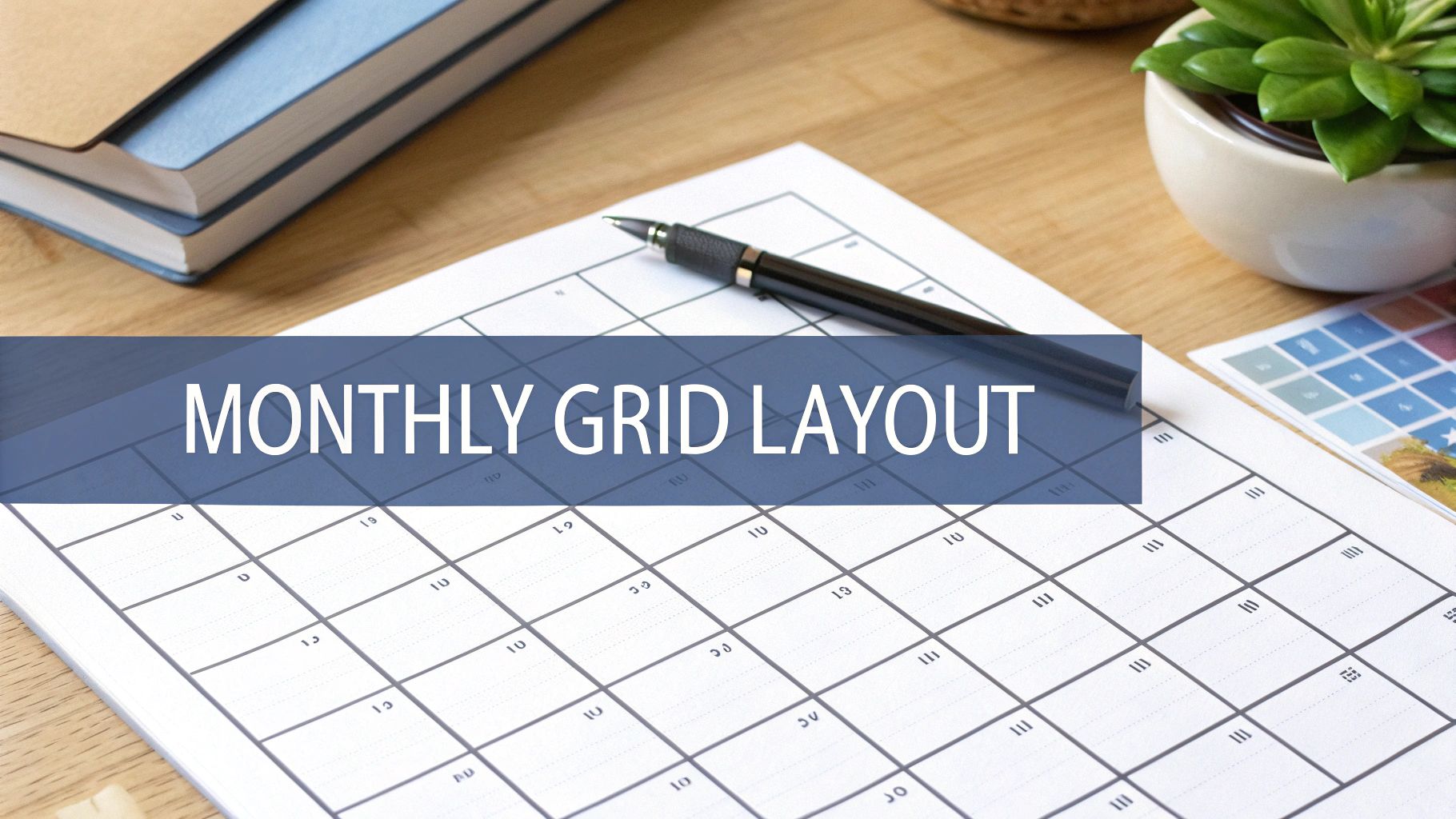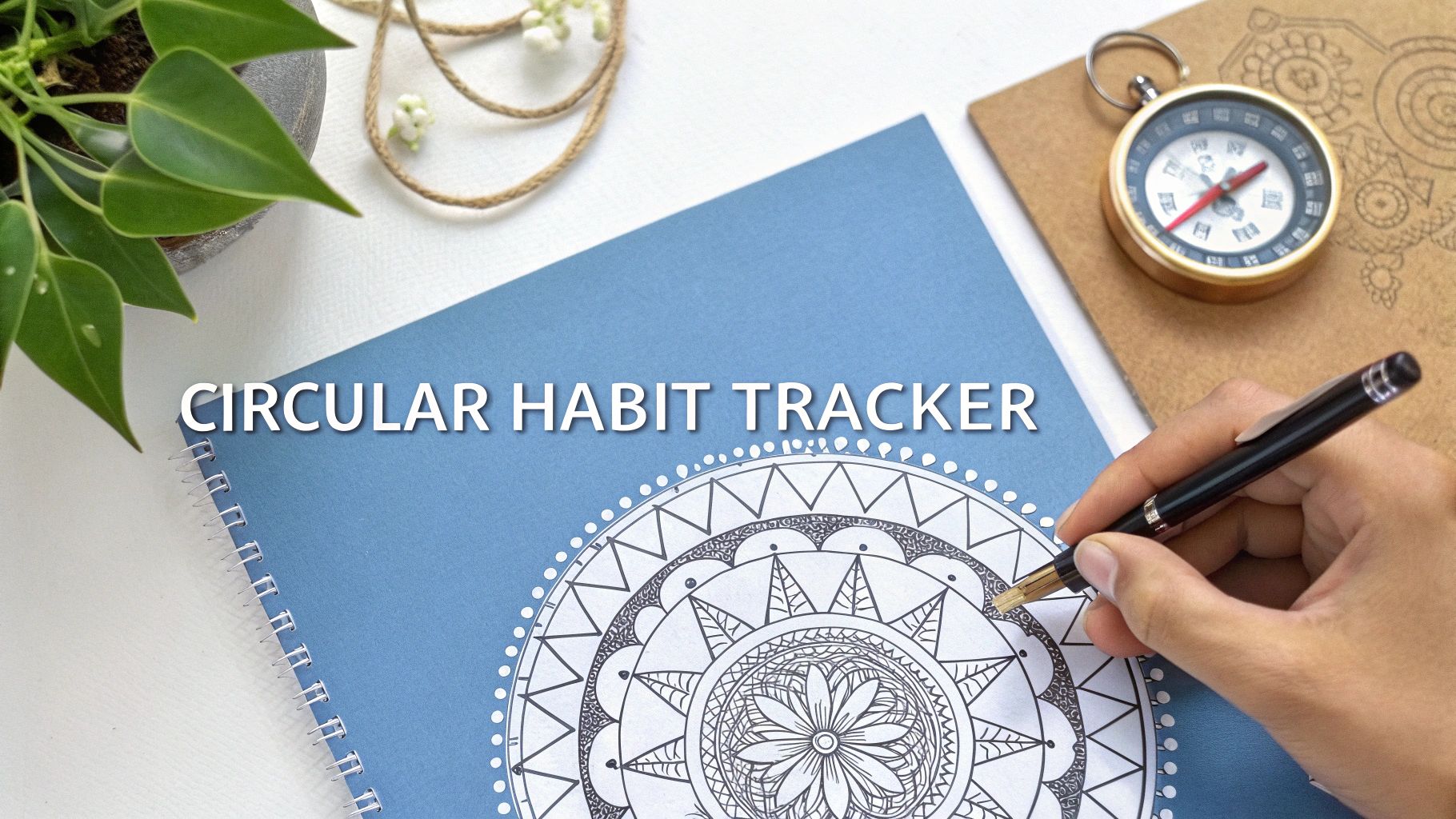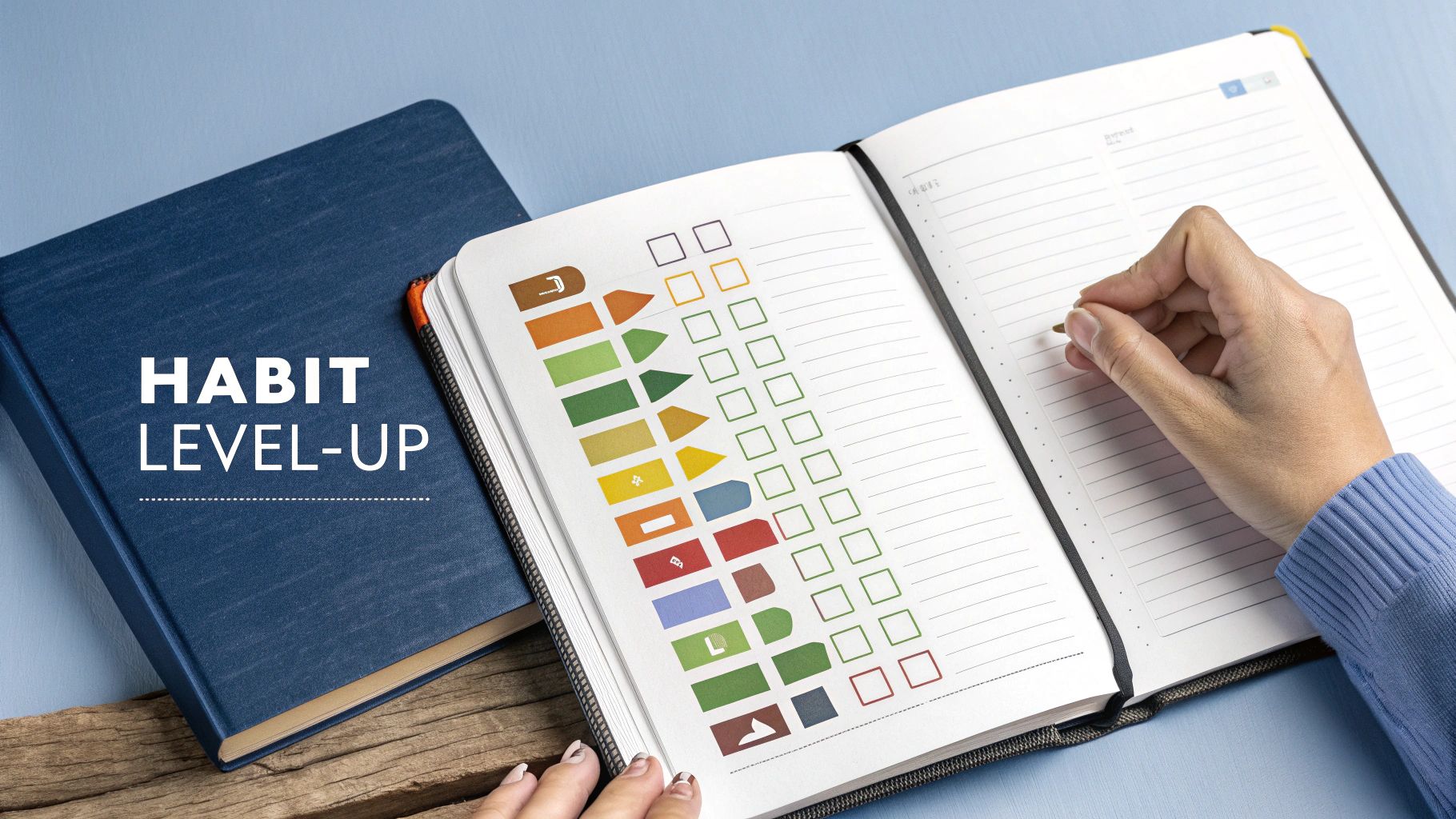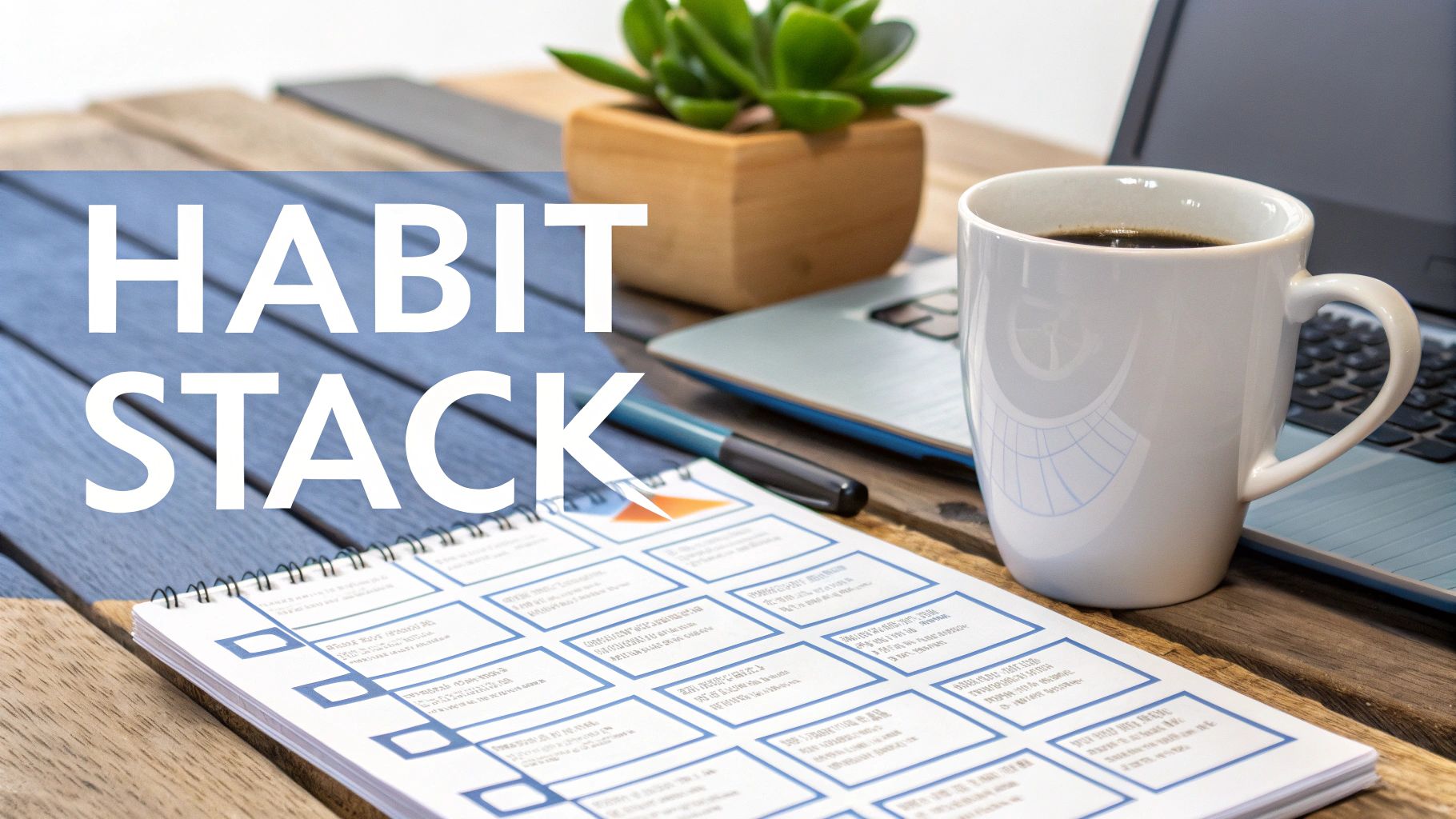Feel like you’re running in circles, unable to stick with those healthy habits you know would make a difference?
You’re definitely not alone.
Maintaining focus and consistency can feel impossible between constant notifications pinging our phones and endless to-do lists. This is especially true for entrepreneurs, small business owners, and content creators managing multiple projects at once.
Enter the bullet journal – a flexible, hands-on system for organizing your life and tracking your habits.
Level Up Your Life: Mastering Habit Tracking with Your Bullet Journal
The bullet journal has come a long way from its beginnings as a simple rapid logging method created by Ryder Carroll. While it’s now massively popular on social media, the core principles remain the same – rapid logging, indexing, and thoughtfully moving tasks forward. What makes this method click for so many people is how adaptable it is.
Unlike pre-printed planners that force you into one system, a bullet journal lets you design a personalized approach that fits your brain, whether you’re motivated by visuals, data, or turning tasks into a game.
Ready to level up your habit-tracking game?
In this guide, we’ll explore 8 different bullet journal layouts designed for various learning styles and preferences. The combination of principle comprehension and personalized layout selection will establish permanent positive behaviors alongside productivity growth. It is time to establish enduring positive modifications.
Let’s dive in and discover the perfect habit tracking system for you.
1. Monthly Grid Layout
Having trouble tracking your habits?
The monthly grid layout in bullet journals might be just what you need. This simple but effective system gives you a clear view of your progress through each month. Picture a grid where days run across the top and your habits line up on the side – perfect for keeping tabs on multiple activities at once.

With spaces for each day of the month, you can easily spot when you’re most likely to stick to (or skip) your habits. Maybe you notice you always exercise on weekdays but rarely on weekends – that’s valuable insight! Plus, adding colors makes it fun and helps you quickly tell different habits apart.
This tracking method has earned praise from bullet journal experts like Ryder Carroll and Boho Berry. They know firsthand how well it works for people wanting a simple way to stay organized.
Want to learn more about bullet journaling basics? Check out Everything About the Bullet Journal.
Features and Benefits:
- Full Month View: See all 31 days at once for better planning
- Color Options: Make your tracker both pretty and practical
- Quick Progress Checks: See how you’re doing at a glance
- Multi-Habit Tracking: Keep all your habits in one neat spot
Pros:
- Monthly Overview: Get the big picture of your progress
- Pattern Recognition: See what works and what doesn’t
- Space Saving: Fits lots of info in a small area
- Quick Updates: Takes just seconds each day
Cons:
- Limited Details: Not much room for notes
- Potential Mess: Can get busy with too many habits
- Monthly Setup: Needs preparation before each new month
Tips for Success:
- Keep it Simple: Track 8-10 habits max
- Use Basic Marks: Stick to checkmarks or dots
- Add a Legend: Define what your symbols mean
- Save Room for Notes: Leave space for quick comments
Whether you’re an entrepreneur who gets distracted easily or someone trying to simplify their life, this layout can help you stay focused and reach your goals. Its clean design keeps everything clear and organized, making habit tracking feel less like a chore and more like a helpful tool for growth.
2. Weekly Habit Timeline
The Weekly Habit Timeline method gives you a bigger view of your habits and routines. Think of it as a vertical planner with plenty of space for each day of the week. Instead of just marking off tasks, you can write notes about what worked well, how you felt, and the results you got.
Want to build a steady content creation schedule?
On a Weekly Habit Timeline, you can track when you posted, what platform you used, and how your audience responded. Maybe you’ll find you get better engagement on Wednesdays or feel more creative in the mornings. These helpful insights come from having space to write detailed notes about your habits.
One of the best things about this layout is that you can make it work for you. If you want to track time-based habits like morning meditation or evening workouts, just add time blocks to your timeline. For layout ideas, check out The Art of Planning: 5 Inspiring Bujo Weekly Spread Designs. Seeing your habits mapped out in time helps spot any scheduling conflicts.
This tracking style became well-known through bullet journal enthusiasts like AmandaRachLee and Plant Based Bride. They showed how adding mood tracking and color-coding can help you learn even more about your habits.
Features:
- Vertical timeline format: See your whole week at a glance
- Daily sections: Clear space for each day’s habits
- Notes area: Room to write observations and details
- Detailed tracking: Record times, numbers, and other key info
Pros:
- More room for details: Capture the full story of your habits
- Flexible design: Adapt it to fit your needs
- Works well with schedules: Easy to plan time-based habits
- Space for reflection: Write notes about what you learn
Cons:
- Takes time to set up: Needs more planning than simple trackers
- Uses more space: May not work in small notebooks
- Weekly view only: Need multiple pages to see longer periods
Tips for Success:
- Add time blocks: Map out when habits happen in your day
- Track your mood: See how it affects your habits
- Use color coding: Make different habits easy to spot
- Write weekly summaries: Review progress and plan ahead
The Weekly Habit Timeline works well for people who want to understand their habits deeply. It’s perfect for entrepreneurs and content creators juggling complex schedules. While it takes more setup time, the insights you gain make it worth the effort. Read also: [guides on digital decluttering] to help you focus on what matters most.
3. Circular Habit Tracker
Love visual organization? The circular habit tracker offers a fresh take on tracking your progress. Picture a wheel with your habits arranged around a central point, creating what looks like a mandala. You can color in segments for each day, week, or month to build a beautiful record of your journey.

This design works beautifully for tracking habits over extended periods. One popular approach is the “Year in Pixels” – each segment represents a day, and you fill it with colors based on your mood or success with habits. The “Mood Mandala” is another fun variation that captures the natural ebb and flow of emotions.
While regular trackers work fine for daily habits, circular trackers shine when looking at the big picture. There’s something deeply satisfying about watching the circle fill up over time. This style especially appeals to creative types and bullet journal fans who want their planning tools to double as art.
Key Features:
- Eye-catching circular design: Makes tracking feel more like creating art than checking boxes. Perfect for visual thinkers who get bored with standard formats.
- Clear progress view: Easily spot patterns and streaks as you fill in segments.
- Room for creativity: Add your personal flair with colors, patterns and decorative elements.
- Space-saving layout: Fits lots of tracking into a compact space.
- Perfect for yearly views: Great for long-term projects and yearly planning.
Advantages:
- Looks beautiful and keeps you engaged
- Takes up minimal space
- Shows progress in a satisfying way
- Works well for long-term tracking
Challenges:
- Takes time to set up properly
- Can get crowded with multiple habits
- Limited space for lots of habits
Setup Tips:
- Draft with pencil first: Makes it easy to adjust as needed
- Use proper drawing tools: A compass helps create clean circles
- Make a test version: Try different layouts before committing
- Start simple: Begin with just a few key habits, then expand as you get comfortable
With these guidelines in mind, you can create an attractive and practical circular tracker that makes building good habits feel like creating art. This approach works especially well for visual learners and anyone who wants to bring some creative joy to their habit-building journey.
4. Habit Level-Up System
Ready to turn your habit tracking into an exciting game?
The Habit Level-Up System is inspired by video games, making daily tasks feel more like leveling up a character than checking off boxes. You earn experience points (XP) for completing tasks and unlock achievements as you reach milestones. It’s a fun twist that makes habit-building more engaging.

This approach became widely popular through apps like Habitica, which turns daily routines into epic quests. The Bullet Journal community has also created many creative versions. The system works because it taps into our natural drive for achievement and progress.
How it Works:
The system uses familiar game elements like progress bars, levels, and achievement badges. For example, writing 500 words might earn you 10 XP. Once you collect enough XP, you level up and unlock rewards you’ve chosen for yourself – maybe a new book or an evening off. This clear path of progress helps keep you moving forward.
Real-World Example:
Picture yourself as a content creator working to post more regularly. You could earn XP for drafting, editing, and publishing each post. When you reach new levels, you get rewards like buying that course you’ve been eyeing or taking a day for creative exploration. This makes the writing process more fun and rewarding.
Pros:
- Keeps You Motivated: The game-like elements make progress exciting and visible
- Makes Tracking Fun: Turns routine tasks into an enjoyable activity
- Shows Clear Progress: Gives you a visual map of your improvements
- Perfect for Goal-Setters: Appeals to people who like achieving and competing
Cons:
- Takes More Setup: You need to design and maintain the XP and level system
- Needs Regular Updates: Requires active management to stay effective
- Not for Everyone: Some people may prefer simpler tracking methods
Tips for Implementation:
- Define Level Requirements: Set clear XP targets for reaching each new level
- Add Meaningful Rewards: Connect levels to rewards that matter to you
- Keep it Simple: Start with basic rules and add complexity only if needed
- Set Clear Goals: Create specific targets for each level (like “Level 3: Write 10 Blog Posts”)
The Habit Level-Up system delivers exceptional value because it offers genuine satisfaction for habit formation. The transformation of ordinary tasks into games makes the process of habit-building attractive to entrepreneurs dealing with ADD alongside productivity enthusiasts and content creators who desire an enjoyable self-improvement experience. People can develop valuable habits through this method which also provides entertainment during the process.
5. Mini Habit Dashboard
The Mini Habit Dashboard functions as an exceptional tracking platform which suits creators and entrepreneurs who need to manage various goals efficiently. The tracking system works as a small interface which allows you to monitor various life habits simultaneously without becoming confused like obtaining a central display to track your everyday achievements.
This clever layout came about because traditional habit trackers take up too much space in bullet journals. While old-school trackers dedicate large chunks to each habit, the Mini Habit Dashboard keeps things tight and tidy, making it perfect for minimalist journal spreads.
What is it?
Think of the Mini Habit Dashboard as your personal mission control center. It combines several small trackers for different habit categories into one neat space. Instead of habits sprawling across multiple pages, everything stays organized in bite-sized sections.
Key Features:
- Mini trackers: Each habit gets its own small, focused tracking area
- Smart grouping: Related habits sit together visually so you can see progress in specific areas
- Quick scanning: The compact design lets you check progress in seconds
- Space-saving layout: Makes the most of your journal real estate
Pros:
- Super efficient: Works great in smaller notebooks
- Quick updates: Takes just seconds to mark off habits
- Handles variety: Track anything from water intake to work tasks
- Flexible design: Easy to customize for your needs
Cons:
- Can get crowded: Needs thoughtful planning to stay neat
- Limited tracking space: Not great for complex habit tracking
- Setup matters: Takes initial planning to work well
Real-World Examples:
Consider a content creator using it to track daily writing, social posts, and email campaigns – each with simple checkboxes. Or picture an entrepreneur monitoring sales calls, networking, and daily tasks. Many minimalist bullet journal users show how well this works across different lifestyles.
Tips for Success:
- Bundle similar habits: Keep related items together (like all health habits in one spot)
- Use simple icons: Save space with small symbols instead of words
- Add weekly summaries: Include a tiny progress recap for each category
- Monthly check-ins: Take time each month to adjust your dashboard as needed
The Mini Habit Dashboard stands out for its simple but mighty approach to tracking multiple habits without eating up your journal space or time. Its smart design and quick-check format make it perfect for busy people who want to stay organized without fuss. If you need a way to track habits more efficiently, try this dashboard style.
6. Habit Streak Tracker
Want to build better habits? The Habit Streak Tracker is a simple but powerful bullet journal tool that helps track consistent daily habits. Creating a visual chain of completed tasks allows you to easily monitor your progress and stay motivated.
The concept is beautifully simple – each day you complete your chosen habit, you add another link to your visual chain. As the chain grows longer, you clearly understand your dedication and feel more driven to maintain your streak.
Key Features:
- Daily Streak Counter: Track exactly how many consecutive days you’ve kept up your habit
- Visual Progress Chain: Watch your chain grow day by day for added motivation
- Custom Tracking: Use colors or symbols to highlight milestones
- Set Target Streaks: Work toward specific streak lengths like 30 days
How It Works in Practice: Let’s say you want to write 500 words daily. Each day you hit your word count goal, you mark it off. The growing chain of completed days becomes a powerful reminder to keep writing and avoid breaking your streak.
This method gained popularity through Jerry Seinfeld’s productivity system and was further explored in James Clear’s book Atomic Habits. The visual nature of tracking taps into our natural desire to maintain progress.
Benefits:
- Perfect for visual learners
- Makes progress easy to measure
- Helps build lasting habits
Potential Challenges:
- Can create pressure for perfectionists
- Breaking streaks may feel discouraging
- May lead to unhealthy perfectionism if not balanced
Tips for Success:
- Have a Reset Plan: Life happens – decide in advance how you’ll handle broken streaks
- Start Small: Begin with achievable goals to build momentum
- Track Personal Records: Note your longest streaks for motivation
- Schedule Rest Days: Build in planned breaks to avoid burnout, especially important for solo entrepreneurs. Check out this helpful Productivity Tracker Template for scheduling breaks.
Read also: [Tips for Digital Decluttering Your Workspace] (This is a placeholder; replace with a real link if available). A tidy digital space can boost productivity just like an organized bullet journal.
The Habit Streak Tracker stands out because it offers a straightforward, visual way to build consistent habits. While it’s important to use it mindfully and avoid perfectionism, the motivational power of maintaining an unbroken chain can help anyone improve their productivity – from entrepreneurs with ADD to content creators to anyone working on personal growth.
7. Habit Stack Tracker
The Habit Stack Tracker is a fantastic tool for anyone looking to build solid routines, particularly helpful for entrepreneurs with ADD, solo business owners, and productivity seekers. Based on ideas from James Clear and BJ Fogg, habit stacking links multiple actions together, creating a natural flow of positive behaviors.

The tracker uses a simple checklist format organized by time or routine groups. For example, a morning stack could flow like this: 1. Wake up > 2. Drink water > 3. Meditate for 10 minutes > 4. Journal for 5 minutes > 5. Plan your day. Each completed action naturally leads to the next one, making it easier to build complex habits into your daily life.
Here’s a real example shared by James Clear: Someone wanted to make flossing a daily habit. They added flossing right after brushing their teeth – an already solid habit. Flossing became a natural part of their routine by connecting the new behavior to an existing one.
For content creators battling distractions, a focused work stack might look like: 1. Close social media tabs ➡️ 2. Turn on website blocker ➡️ 3. Set 30-minute timer for writing ➡️ 4. Take 5-minute break to stretch and drink water. This creates a clear workflow that helps maintain focus.
Pros:
- Makes routines stick through connected actions
- Shows clear steps to follow
- Helps new habits feel natural
- Fits smoothly into existing routines
Cons:
- Less flexible than other tracking methods
- Needs careful planning at first
- Can feel like too much if you add too many habits at once
Tips for Success:
- Start small: Begin with 2-3 linked habits
- Connect to current habits: Add new actions to things you already do
- Note time needed: Add rough estimates (5 min meditation, 10 min journal)
- Check and update often: Change your stacks as your needs change
You might enjoy reading more about Habits vs. Rituals to better understand how to build lasting behaviors. This article helps you shape your bullet journal to match your needs.
The Habit Stack Tracker provides straightforward methods to enhance productivity through an organized system of better routines. Thoughtful planning of habit stacks allows you to move forward toward your goals through controlled progress.
8. Habit Energy Map
Ever wondered why some days you breeze through tasks while other days feel like wading through mud? The Habit Energy Map stands as your essential missing element for tracking purposes. This functional tracking methodology shows you your work optimization times by linking personal daily activities with natural energy cycles and emotional variations.
Use this tool to discover your energy patterns since it identifies the times you are motivated and the times you need rest. The tracking system records your daily energy levels together with your mood at certain times of day and your achievement status of completing each habit. The recorded information enables you to identify distinct patterns that develop over time.
Understanding your body’s natural time cycles creates genuine advantages. The right time for writing tasks emerges early in the day while exercise success occurs during afternoon hours. You will improve your success rate by arranging your activities to align with the times when your body performs at its best.
The system works based on successful methods, such as chronotype monitoring of sleep patterns and performance recordkeeping, which athletes use to enhance training. The Habit Energy Map unifies these fundamental insights by creating a basic system for constructing better habits.
Some difficulties must be taken into account when implementing this approach. The tracking process using this method requires superior detail compared to standard habit checklists. It also requires several weeks to produce significant patterns from your data. However, for many people, the insights gained are worth the extra effort.
Here are some practical tips for getting started with your Habit Energy Map:
- Track energy levels throughout the day: Use a simple 1-5 scale to rate your energy (1=lowest, 5=highest) at regular intervals
- Note external factors: Record things like sleep quality, stress levels, or meals that might affect your energy
- Include success ratings: Mark whether you completed each habit and how easy or difficult it felt
- Review weekly for patterns: Look for connections between your energy, mood, timing, and success rates
You might be interested in: How to Track Your Health & Fitness in Your Bullet Journal in 2025. This article provides more ideas for tracking health and habits in your bullet journal.
Whether you’re a business owner managing ADD, a content creator seeking flow states, or anyone looking to build better habits, the Habit Energy Map offers valuable insights into your personal patterns. While it takes some dedication to maintain, understanding your natural rhythms can dramatically improve your success with habits and productivity. Even in our tech-focused world, this analog tracking method helps you tune into your body’s natural cycles and work with them rather than against them.
8 Habit Tracker Bullet Journal Layouts: Comparison Overview
| Method | Difficulty | Time Required | Results | Best For | Key Benefit |
|---|---|---|---|---|---|
| Monthly Grid Layout | Low 🔄 | ⚡ Fast | 📊 Clear monthly overview | Multi-habit trackers | Easy pattern recognition |
| Weekly Habit Timeline | Medium 🔄 | ⚡ Moderate | 📊 Detailed, note-friendly tracking | Time-specific habit planners | Enhanced daily details |
| Circular Habit Tracker | High 🔄 | ⚡ Slow | 📊 Visually engaging progress | Visual motivators & annual trackers | Unique artistic design |
| Habit Level-Up System | Medium-High 🔄 | ⚡ Moderate | 📊 Motivational progression | Gamification fans & goal-oriented | Clear progression and rewards |
| Mini Habit Dashboard | Low-Medium 🔄 | ⚡ Fast | 📊 Compact summary tracking | Multi-category habit trackers | Space-efficient overview |
| Habit Streak Tracker | Low 🔄 | ⚡ Fast | 📊 Clear streak metrics | Consistency builders | Encourages daily continuity |
| Habit Stack Tracker | Medium 🔄 | ⚡ Moderate | 📊 Structured routine tracking | Routine builders | Establishes clear habit triggers |
| Habit Energy Map | High 🔄 | ⚡ Slow | 📊 Personalized insights | Self-optimization seekers | Optimizes timing based on energy/mood |
Your Bullet Journal: Your Habit Haven
A bullet journal can be an incredible tool for building better habits. With 8 different habit tracker layouts – from Monthly Grids to Energy Maps – you have plenty of options to find what works for you. The key is making it your own. Feel free to mix and match layouts, adjust them to your style, and discover what helps you stay consistent. Some people love the visual appeal of circular trackers, while others get motivated by leveling up their habits and game style.
Getting started is simple. Pick a few key habits you want to focus on first, then choose a layout that matches how you like to track things. Start with just 2-3 habits to avoid getting overwhelmed. Remember that checking off even one box each day helps build momentum. Those small wins add up to create lasting change.
Your tracking system should grow with you. As your needs and goals shift over time, don’t hesitate to switch up your layouts. The beauty of bullet journaling is that you can adapt it however you want. If something stops working, try a different approach. Your journal should be a helpful tool, not a source of stress.
New bullet journal trends, from minimalist designs to digital hybrid approaches, keep emerging. We’re seeing more focus on mindfulness and self-care in habit tracking. This makes sense – the goal isn’t just to check boxes, but to create sustainable routines that help you thrive.
Key ideas to remember: Try different approaches until you find what clicks. Stay consistent with your tracking. Be willing to adjust your system as needed. Your bullet journal is meant to support your unique journey.
Want to take your productivity and organization to the next level? Visit Lorelei Web for practical strategies designed especially for entrepreneurs with ADD. You’ll find actionable tips for business management, content marketing, and digital organization – including bullet journaling techniques. Join our supportive community and get the tools you need to stay focused and achieve your goals.

Lorelei has been an online entrepreneur, marketer and writer since 2006. Her biggest passion is WordPress, which is why she switched to being a full-time blogger 20 years ago and hasn’t looked back since. With so many years of experience behind her, she is an expert in copywriting, SEO, marketing and business strategies.





